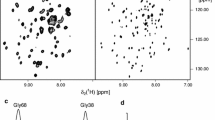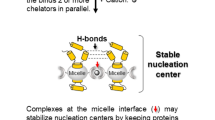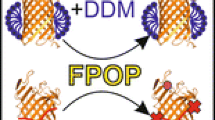Abstract
Amphipols are short amphipathic polymers designed to stabilize membrane proteins in aqueous solutions in the absence of detergent. Bacteriorhodopsin (BR), a light-driven proton pump, has been denatured, either by direct solubilization of the purple membrane in sodium dodecylsulfate (SDS) solution or by a procedure that involves delipidation with organic solvent followed by transfer to SDS, and renatured in amphipol A8-35. The effect of different renaturation procedures and of the presence or absence of lipids and the cofactor retinal have been investigated. The resulting samples have been characterized by absorbance spectroscopy, size-exclusion chromatography, thermostability measurements, and determination of photocycle kinetics. Transfer to A8-35 can be achieved by SDS precipitation, dilution, or dialysis, the first route resulting in the highest yield of refolding. Functional BR can be refolded whether in the presence or absence of lipids, higher yields being achieved in their presence. Retinal is not required for the protein to refold, but it stabilizes the refolded form and, thereby, improves folding yields. Lipids are not required for BR to perform its complete photocycle, but their presence speeds up the return to the ground state. Taken together, these data indicate that a membrane or membrane-mimetic environment is not required for correct decoding of the chemical information contained in the sequence of BR; functional folding is possible even in the highly foreign environment of lipid-free amphipols. BR interactions with lipids, however, contribute to an effective photocycle.








Similar content being viewed by others
References
Althoff T, Mills DJ, Popot J-L, Kühlbrandt W (2011) Assembly of electron transport chain components in bovine mitochondrial supercomplex I1III2IV1. EMBO J 30:4652–4664
Anfinsen CB (1973) Principles that govern the folding of protein chains. Science 181:223–230
Anfinsen CB, Harber E, Sela M (1961) The kinetics of formation of native ribonuclease during oxidation of the reduced polypeptide chain. Proc Natl Acad Sci USA 47:1309–1314
Banères J-L, Popot J-L, Mouillac B (2011) New advances in production and functional folding of G protein-coupled receptors. Trends Biotechnol 29:314–322
Bazzacco P, Billon-Denis E, Sharma KS, Catoire LJ, Mary S, Le Bon C, Point E, Banères J-L, Durand G, Zito F, Pucci B, Popot J-L (2012) Non-ionic homopolymeric amphipols: application to membrane protein folding, cell-free synthesis, and solution NMR. Biochemistry 51:1416–1430
Béal D, Rappaport F, Joliot P (1999) A new high-sensitivity 10-ns time-resolution spectrophotometric technique adapted to in vivo analysis of the photosynthetic apparatus. Rev Sci Inst 70:202–207
Booth PJ, Templer RH, Meijberg W, Allen SJ, Curran AR, Lorch M (2001) In vitro studies of membrane protein folding. Crit Rev Biochem Mol Biol 36:501–603
Buchanan SK (1999) Beta-barrel proteins from bacterial outer membranes: structure, function and refolding. Curr Opin Struct Biol 9:455–461
Catoire LJ, Damian M, Giusti F, Martin A, van Heijenoort C, Popot J-L, Guittet E, Banères J-L (2010a) Structure of a GPCR ligand in its receptor-bound state: leukotriene B4 adopts a highly constrained conformation when associated to human BLT2. J Am Chem Soc 132:9049–9057
Catoire LJ, Zoonens M, van Heijenoort C, Giusti F, Guittet E, Popot J-L (2010b) Solution NMR mapping of water-accessible residues in the transmembrane β-barrel of OmpX. Eur Biophys J 39:623–630
Champeil P, Menguy T, Tribet C, Popot J-L, le Maire M (2000) Interaction of amphipols with the sarcoplasmic reticulum Ca2+-ATPase. J Biol Chem 275:18623–18637
Corcelli A, Lattanzio VMT, Mascolo G, Papadia P, Fanizzi F (2002) Lipid-protein stoichiometries in a crystalline biological membrane: NMR quantitative analysis of the lipid extract of the purple membrane. J Lipid Res 43:132–140
Dahmane T, Damian M, Mary S, Popot J-L, Banères J-L (2009) Amphipol-assisted in vitro folding of G protein-coupled receptors. Biochemistry 48:6516–6521
Dahmane T, Giusti F, Catoire LJ, Popot J-L (2011) Sulfonated amphipols: synthesis, properties and applications. Biopolymers 95:811–823
Duarte AMS, Wolfs CJAM, Koehorsta RBM, Popot J-L, Hemminga MA (2008) Solubilization of V-ATPase transmembrane peptides by amphipol A8-35. J Pept Chem 14:389–393
Fitter J, Verclas SAW, Lechner RE, Seelert H, Dencher NA (1998) Function and picosecond dynamics of bacteriorhodopsin in purple membrane at different lipidation and hydration. FEBS Lett 433:321–325
Fukuda K, Ikegami A, Nasuda-Kouyama A, Kouyama T (1990) Effect of partial delipidation of purple membrane on the photodynamics of bacteriorhodopsin. Biochemistry 29:1997–2002
Gohon Y, Pavlov G, Timmins P, Tribet C, Popot J-L, Ebel C (2004) Partial specific volume and solvent interactions of amphipol A8-35. Anal Biochem 334:318–334
Gohon Y, Giusti F, Prata C, Charvolin D, Timmins P, Ebel C, Tribet C, Popot J-L (2006) Well-defined nanoparticles formed by hydrophobic assembly of a short and polydisperse random terpolymer, amphipol A8-35. Langmuir 22:1281–1290
Gohon Y, Dahmane T, Ruigrok R, Schuck P, Charvolin D, Rappaport F, Timmins P, Engelman DM, Tribet C, Popot J-L, Ebel C (2008) Bacteriorhodopsin/amphipol complexes: structural and functional properties. Biophys J 94:3523–3537
Hartsel SC, Cassim JY (1988) Structure and photodynamics of bacteriorhodopsin in a delipidated contracted lattice form of purple membrane. Biochemistry 27:3720–3724
Haupts U, Tittor J, Oesterhelt D (1999) Closing in on bacteriorhodopsin: progress in understanding the molecule. Annu Rev Biophys Biomol Struct 28:367–399
Henderson R, Unwin PNT (1975) Three-dimensional model of purple membrane obtained by electron microscopy. Nature 257:28–32
Henderson R, Baldwin JM, Ceska TA, Zemlin F, Beckmann E, Downing KH (1990) Model for the structure of bacteriorhodopsin based on high resolution electron cryo-microscopy. J Mol Biol 213:899–929
Hendler RW, Bose S (2003) Interconversions among four M-intermediates in the bacteriorhodopsin photocycle. Eur J Biochem 270:3518–3524
Hendler RW, Dracheva S (2001) Importance of lipids for bacteriorhodopsin structure, photocycle, and function. Biochemistry (Mosc.) 66:1311–1314
Huang K-S, Bayley H, Liao M-J, London E, Khorana HG (1981) Refolding of an integral membrane protein. Denaturation, renaturation, and reconstitution of intact bacteriorhodopsin and two proteolytic fragments. J Biol Chem 256:3802–3809
Jackson MB, Sturtevant JM (1978) Phase transitions of the purple membranes of Halobacterium halobium. Biochemistry 17:911–915
Jang DJ, el-Sayed MA (1988) Deprotonation of lipid-depleted bacteriorhodopsin. Proc Natl Acad Sci USA 85:5918–5922
Joshi M, Dracheva S, Mukhopadhyay AK, Bose S, Hendler RW (1998) Importance of specific native lipids in controlling the photocycle of bacteriorhodopsin. Biochemistry 37:14463–14470
Kiefer H (2003) In vitro folding of α-helical membrane proteins. Biochim Biophys Acta 1610:57–62
Liao M-J, Huang K-S, Khorana HG (1984) Regeneration of native bacteriorhodopsin structure from fragments. J Biol Chem 259:4200–4204
London E, Khorana HG (1982) Denaturation and renaturation of bacteriorhodopsin in detergents and lipid-detergent mixtures. J Biol Chem 257:7003–7011
Martinez KL, Gohon Y, Corringer P-J, Tribet C, Mérola F, Changeux J-P, Popot J-L (2002) Allosteric transitions of Torpedo acetylcholine receptor in lipids, detergent and amphipols: molecular interactions vs. physical constraints. FEBS Lett 528:251–256
Milder SJ, Thorgeirsson TE, Miercke LJ, Stroud RM, Kliger DS (1991) Effects of detergent environments on the photocycle of purified monomeric bacteriorhodopsin. Biochemistry 30:1751–1761
Mukerjee P, Mysels KJ (1971) Critical micelle concentrations of aqueous surfactant systems. National Bureau of Standards, Washington, p 227
Mukhopadhyay AK, Dracheva S, Bose S, Hendler RW (1996) Control of the integral membrane proton pump, bacteriorhodopsin, by purple membrane lipids of Halobacterium halobium. Biochemistry 35:1751–1761
Neutze R, Pebay-Peyroula E, Edman K, Royant A, Navarro J, Landau EM (2002) Bacteriorhodopsin: a high-resolution structural view of vectorial proton transport. Biochim Biophys Acta 1565:144–167
Oesterhelt D, Stoeckenius W (1974) Isolation of the cell membrane of Halobacterium halobium and its fractionation into red and purple membrane. Methods Enzymol 31:667–678
Park E, Rapoport TA (2012) Mechanisms of Sec61/SecY-mediated protein translocation across membranes. Annu Rev Biophys 41:21–40
Perlmutter JD, Drasler WJ, Xie W, Gao J, Popot J-L, Sachs JN (2011) All-atom and coarse-grained molecular dynamics simulations of a membrane protein stabilizing polymer. Langmuir 27:10523–10537
Picard M, Dahmane T, Garrigos M, Gauron C, Giusti F, le Maire M, Popot J-L, Champeil P (2006) Protective and inhibitory effects of various types of amphipols on the Ca2+-ATPase from sarcoplasmic reticulum: a comparative study. Biochemistry 45:1861–1869
Pocanschi CL, Dahmane T, Gohon Y, Rappaport F, Apell H-J, Kleinschmidt JH, Popot J-L (2006) Amphipathic polymers: tools to fold integral membrane proteins to their active form. Biochemistry 45:13954–13961
Popot J-L (2010) Amphipols, nanodiscs, and fluorinated surfactants: three non-conventional approaches to studying membrane proteins in aqueous solutions. Annu Rev Biochem 79:737–775
Popot J-L, Trewhella J, Engelman DM (1986) Reformation of crystalline purple membrane from purified bacteriorhodopsin fragments. EMBO J 5:3039–3044
Popot J-L, Gerchman S-E, Engelman DM (1987) Refolding of bacteriorhodopsin in lipid bilayers: a thermodynamically controlled two-stage process. J Mol Biol 198:655–676
Popot J-L, Althoff T, Bagnard D, Banères J-L, Bazzacco P, Billon-Denis E, Catoire LJ, Champeil P, Charvolin D, Cocco MJ, Crémel G, Dahmane T, de la Maza LM, Ebel C, Gabel F, Giusti F, Gohon Y, Goormaghtigh E, Guittet E, Kleinschmidt JH, Kühlbrandt W, Le Bon C, Martinez KL, Picard M, Pucci B, Rappaport F, Sachs JN, Tribet C, van Heijenoort C, Wien F, Zito F, Zoonens M (2011) Amphipols from A to Z. Annu Rev Biophys 40:379–408
Rehorek M, Heyn MP (1979) Binding of all-trans-retinal to the purple membrane. Evidence for cooperativity and determination of the extinction coefficient. Biochemistry 18:4977–4983
Riley ML, Wallace BA, Flitsch SL, Booth PJ (1997) Slow α-helix formation during folding of a membrane protein. Biochemistry 36:192–196
Sharma KS, Durand G, Gabel F, Bazzacco P, Le Bon C, Billon-Denis E, Catoire LJ, Popot J-L, Ebel C, Pucci B (2012) Non-ionic amphiphilic homopolymers: synthesis, solution properties, and biochemical validation. Langmuir 28:4625–4639
Sonar S, Patel N, Fischer W, Rothschild KJ (1993) Cell-free synthesis, functional refolding, and spectroscopic characterization of bacteriorhodopsin, an integral membrane protein. Biochemistry 32:13777–13781
Swords NA, Wallace BA (1993) Circular-dichroism of membrane proteins: examination of environmental effects on bacteriorhodopsin spectra. Biochem J 289:215–219
Tribet C, Audebert R, Popot J-L (1996) Amphipols: polymers that keep membrane proteins soluble in aqueous solutions. Proc Natl Acad Sci USA 93:15047–15050
Váró G (2000) Analogies between halorhodopsin and bacteriorhodopsin. Biochim Biophys Acta 1460:220–229
Váró G, Lanyi JK (1991) Thermodynamics and energy coupling in the bacteriorhodopsin photocycle. Biochemistry 30:5016–5022
White SH, von Heijne G (2008) How translocons select transmembrane helices. Annu Rev Biophys 37:23–42
Zoonens M, Catoire LJ, Giusti F, Popot J-L (2005) NMR study of a membrane protein in detergent-free aqueous solution. Proc Natl Acad Sci USA 102:8893–8898
Zoonens M, Giusti F, Zito F, Popot J-L (2007) Dynamics of membrane protein/amphipol association studied by Förster resonance energy transfer. Implications for in vitro studies of amphipol-stabilized membrane proteins. Biochemistry 46:10392–10404
Acknowledgments
Special thanks are due to Frank Wien (Synchrotron Soleil, Saclay, France) for analyzing samples on the circular dichroism synchrotron beamline Bessy (Helmholtz-Zentrum, Berlin), to Manuela Zoonens (UMR 7099) for her contribution to collecting UV–visible spectra, to Fabrice Giusti (UMR 7099) for the synthesis of amphipol A8-35, and to J. Barra for her kind help with preparation of the figures. This work was supported by the CNRS, by University Paris-7, and by grants from the E.U. (Specific Targeted Research Project LSHGCT-2005-513770 IMPS: Innovative tools for membrane protein structural proteomics) and from the French Ministry of Research (ANR-06-BLAN-0087 Refolding GPCRs). T.D. was the recipient of a fellowship from the Ministère de l’Enseignement Supérieur et de la Recherche.
Author information
Authors and Affiliations
Corresponding author
Additional information
Special Issue: Structure, function, folding, and assembly of membrane proteins—insight from biophysics.
Rights and permissions
About this article
Cite this article
Dahmane, T., Rappaport, F. & Popot, JL. Amphipol-assisted folding of bacteriorhodopsin in the presence or absence of lipids: functional consequences. Eur Biophys J 42, 85–101 (2013). https://doi.org/10.1007/s00249-012-0839-z
Received:
Revised:
Accepted:
Published:
Issue Date:
DOI: https://doi.org/10.1007/s00249-012-0839-z




